Kanji for “Gate”: 門 (kado / mon)
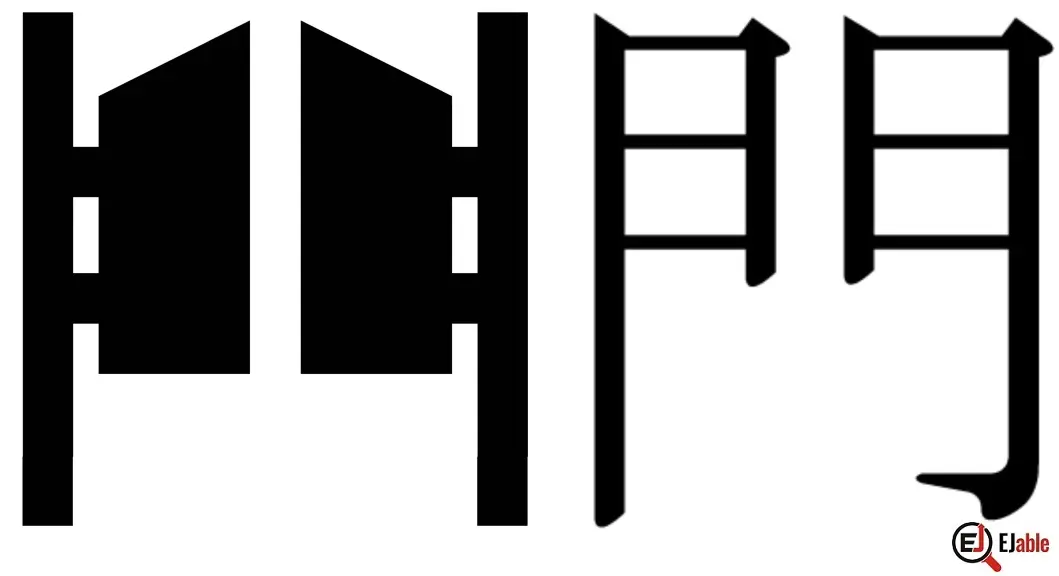
The Japanese kanji for “Gate” is 門.
Please note that 門 typically represents larger gates or doorways, often implying a formal entrance that is part of larger structures or complexes.
門 is used to denote gateways, archways, or large doors that lead into compounds, schools, temples, or any significant buildings or enclosed spaces. The imagery of 門 conveys a sense of openness and accessibility on a broader scale, suitable for public or communal entry points.
The Kanji for less significant doors, like those in the households of the doors of the rooms, is 戸.
The kun’yomi (Japanese reading) pronunciation of the Kanji 門 is “kado” (かど), and the on’yomi (Chinese reading) pronunciation of 門 is “mon” (モン).
The Kanji 門 is widely used in Japanese names and is a part of 2,304 names. However, in names, it is pronounced as “jyō” (じょう), “mo” (も), “to” (と), or “yuki” (ゆき).
The Kanji 門 is constructed with 8 strokes. It is part of the JLPT N2 syllabus. In Japanese schools, this Kanji is taught in grade 2.
Origin of the Shape 門
If we see the old shape of the Kanji 門 in the Oracle Bone Script, it is a pair of swinging doors.
Let’s see the evolution of the shape of the door’s Kanji from ancient times to the current:
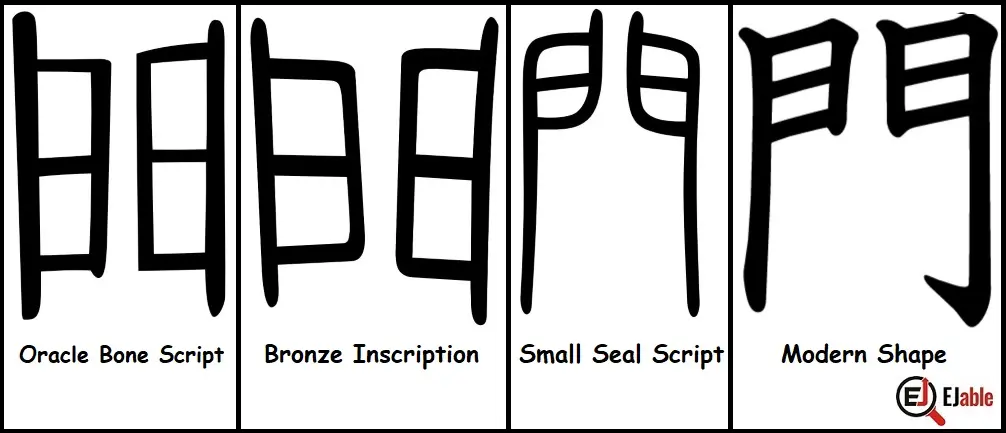
The above image shows the historical shape of 門 in Oracle Bone Script, Bronze inscription, small seal script, and how we write it in the present.
Mnemonic: How to Remember the Kanji Meaning “Gate” (門)
It is quite easy to relate the shape 門 to a gate or door by associating it with its original shape. However, this Kanji is straightforward to remember if we use the following illustration of a gate or door as a mnemonic:
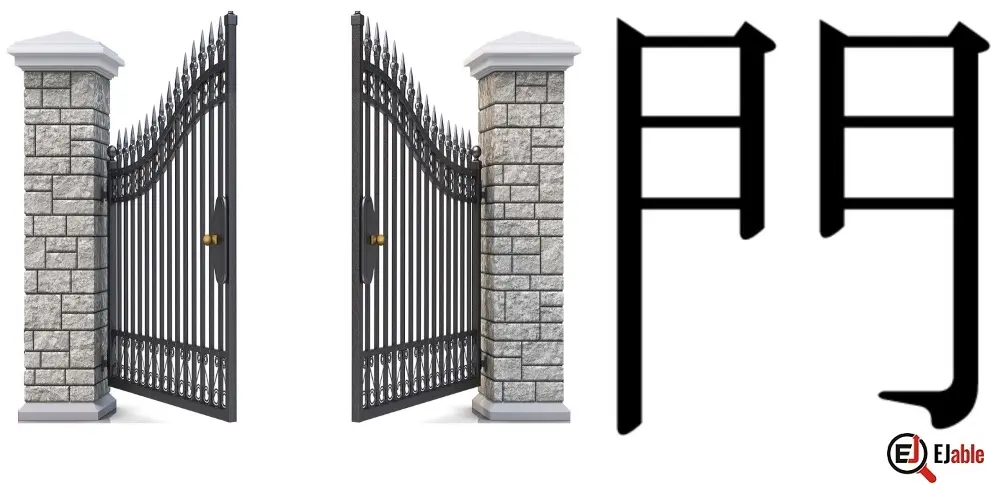
Stroke Order for the Kanji 門
The following illustrations show the order of the 8 strokes to write the Kanji 門:
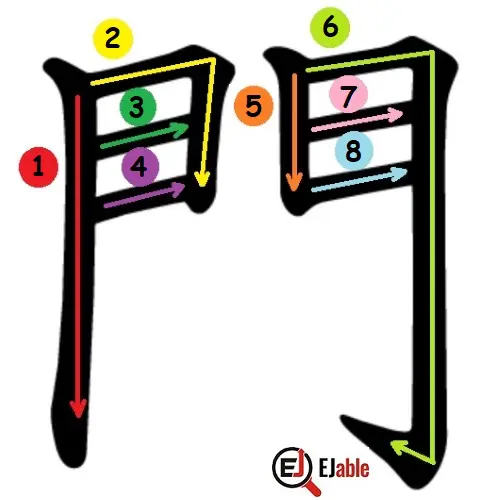
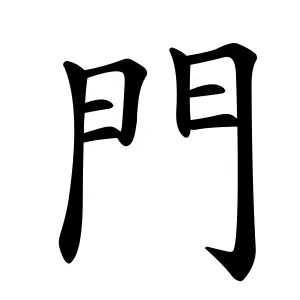
門 as a Radical and Component in other Kanji Characters
The Kanji 門 is used as a radical or component in 138 Kanji characters, out of which 15 are Jōyō (commonly used) Kanji.
In these other Kanji characters, 門 reflects its association with the meaning of gates or doorways extended to various meanings, like physical spaces, actions, qualities, etc.
Examples of 門 as a Radical or Component in Jōyō Kanji
Following are some examples of kanji where 門 (gate or door) appears as a radical or component:
- 間 (かん / けん, kan / ken): Interval or space. This Kanji signifies the space or gap between two points or periods, as if standing at a gate looking through to the other side.
- 聞 (ぶん / もん, bun / mon): Hear. This Kanji suggests receiving sound through an opening, metaphorically like hearing through a gate.
- 開 (かい, kai): Open. 開 represents the action of opening something, akin to swinging a gate wide.
- 問 (もん, mon): Question or ask. This Kanji symbolizes inquiring or seeking entrance to knowledge, as if posing a question at a gate.
- 関 (かん, kan): Related or barrier. This Kanji with “gate” radical implies a connection or a checkpoint, as gates often serve as points of control or entry.
- 閉 (へい, hei): Close. This denotes the act of closing or securing a gate or door.
- 簡 (かん, kan): Simple or simplicity. This character suggests simplification or summarization, metaphorically streamlining to pass through a gate easily.
- 闇 (あん, an): Darkness. 闇 represents darkness or obscurity, as if a gate leads to an unknown, dark place.
- 闘 (とう, tō): Fight, struggle; evokes the concept of combat or contest, metaphorically like a fierce encounter at a gate.
- 閣 (かく, kaku): Towe or, tall building. This meaning implies a structure that stands out like a gate, often associated with higher buildings or levels of government.
- 潤 (じゅん, jun): Moist or “to enrich.” This Kanji shape suggests the nourishment or enrichment that flows through, as water might pass through a gate.
- 閥 (ばつ, batsu): Clique or faction. This character represents a group or clique, as if formed within the gates of power or influence.
- 欄 (らん, ran): Column or railing. The shape of this Kanji denotes a barrier or column, which can be seen as a series of gates or as protective boundaries.
- 閑 (かん, kan): Leisure. This shape conveys a sense of quiet or leisurely space, as if finding peace within a gated area.
- 闇 (えつ, etsu): Review or inspect. The shape of 闇 with “gate” radical signifies the act of inspection or review, metaphorically passing through a gate for examination.
Gate’s Kanji in Compounded Words
The kanji for “gate” 門 forms part of many compound words. There are 68 Japanese words that begin with the Kanji 門, and it appears in 319 words.
Examples of Kanji 門 in Compounded Kanji Characters
- 自動門 (じどうもん / jidōmon): “Automatic gate”; a gate that opens and closes automatically.
- 門前 (もんぜん / monzen): “In front of the gate”; often used to describe the area in front of a temple or school gate.
- 門松 (かどまつ / kadomatsu): New Year pine decoration placed at the entrance of homes to welcome spirits of ancestors.
- 門下 (もんか / monka): “Under a master”; students or disciples under the guidance of a mentor.
- 門番 (もんばん / monban): Gatekeeper; the person in charge of watching and guarding the gate.
- 門構え (もんがまえ / mongamae): “Gate structure”; the architectural style or appearance of a gate.
- 大門 (だいもん / daimon): Large gate; a major or grand entrance to a place.
- 門脈 (もんみゃく / monmyaku): Portal vein; a vein conveying blood to the liver, metaphorically the gate for blood.
- 門徒 (もんと / monto): Followers; particularly in the context of followers of a religion or sect.
- 金門橋 (きんもんきょう / Kinmonkyō) – Golden Gate Bridge; using 門 to denote the “Gate” in the famous landmark.
- 開門 (かいもん / kaimon): “Opening the gate”; the act of opening a gate for entry.
- 閉門 (へいもん / heimon): “Closing the gate”; the act of closing a gate, often at the end of visiting hours.
- 校門 (こうもん / kōmon): School gate; the main entrance to a school.
- 山門 (さんもん / sanmon): Mountain gate; the main gate at the entrance of a Buddhist temple.
- 防火門 (ぼうかもん / bōkamon): Fireproof door; a door designed to prevent the spread of fire.
- 城門 (じょうもん / jōmon): Castle gate; the gate serving as an entrance to a castle.
- 門下生 (もんかせい / monka-sei): “A student of”; someone studying under a particular teacher or at a certain school.
- 専門学校 (せんもんがっこう / senmongakkō): Vocational school; a specialized school focusing on specific fields or vocations.
- 通行門 (つうこうもん / tsūkōmon): Passage gate; a gate used specifically for passing through.
These compound words demonstrate the diverse use of 門 in Japanese. These compounded words with gate’s kanji represent physical structures like gates and doors, as well as some words with an abstract idea of gateways and entrances.
Note: Check other Kanji characters on the page “How to Remember Kanji“.

A long-term ex-pat in Japan, Himanshu comes with an IT background in SAP consulting, IT Business Development, and then running the country operations of an IT consulting multinational. Himanshu is the co-founder and Managing Director of ReachExt K.K. and EJable.com. He is also an Advisory Board Member of a Silicon Valley AI/IoT startup.
